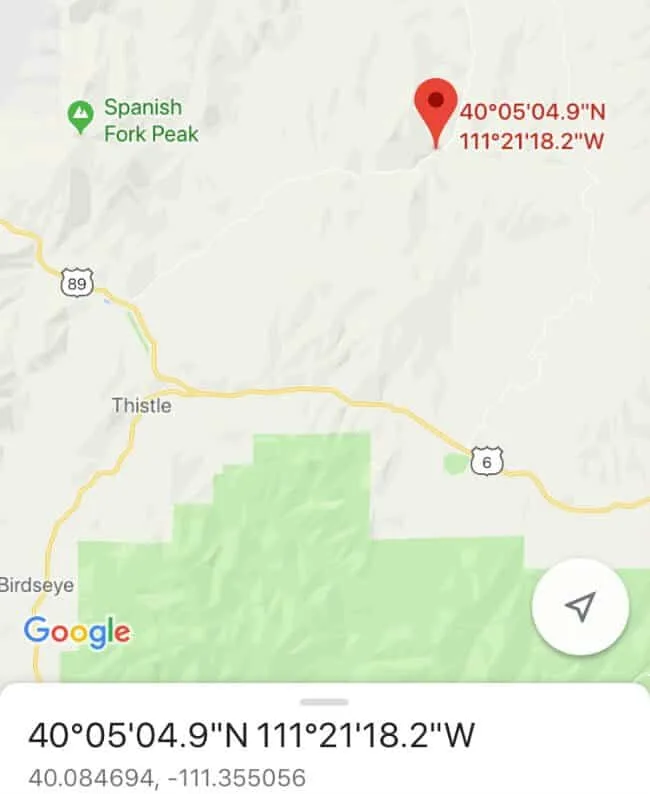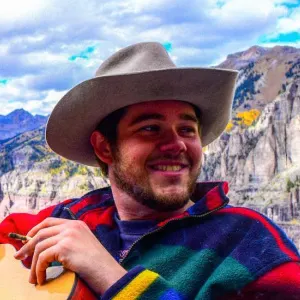About an hour south of Salt Lake City, and a half hour east from Spanish Fork, Utah, is the scenic and alluringly blue natural waters of Diamond Fork Hot Springs in Fifth Water Creek. The hike up to the hot springs and waterfall takes only about an hour for the average hiker on this beautiful out and back trail. I would highly recommend checking it out. Here is the ultimate guide to having an amazing time while there.
NOTE: For reference, this trail is also known as Fifth Water Hot Springs Trail. The two names can be confusing but are essentially referring to the same area; the hot springs trailhead is located off Diamond Fork Road, and is within Diamond Fork Canyon. Thus, it has commonly become known as Diamond Fork Hot Springs as well as Fifth Water Hot Springs.
Where Is It and How To Find It
 Diamond Fork Hot Springs is located at these coordinates, 40°05’04.9″N 111°21’18.2″W, and is easily searchable to find on any smart device connected to the internet. The trailhead itself lies just off of well maintained and paved roads but can get quite busy during peak season in the middle of summer.
Diamond Fork Hot Springs is located at these coordinates, 40°05’04.9″N 111°21’18.2″W, and is easily searchable to find on any smart device connected to the internet. The trailhead itself lies just off of well maintained and paved roads but can get quite busy during peak season in the middle of summer.
Once you reach the trailhead and find parking (more on this below), you will want to stay on the east side of the creek. DO NOT initially cross the footbridge or you will be headed down Second Water Trail, a much longer out and back trail in Cottonwood Canyon.
After about a mile of hiking, you will come to another footbridge which you should cross. This is the junction of Sixth Water Creek from the left, and Fifth Water Creek feeding into it.
About another mile after that, you will see the water in Fifth Water Creek start to turn an ambient blue and you will begin to catch the smell of sulfur in the air. This will let you know that you are very close.
Soon enough, you will see the first lower pool on your right and the subsequent pools are further up until the waterfall.
Parking Information
Make sure you are parked in the lot right at the trailhead or a legal space at other parking areas nearby. The rangers that patrol the Diamond Fork area will write tickets for cars parked illegally so make sure to read the parking signs. You might have to park farther away on the busier days in the summer if you are not there early.
The road may also be snowed in during the winter but there should be parking at the point where they stop plowing. The hot springs will still be open during this season but the further distance could add an hour or more onto a hike during winter seasons.
With the sun setting so much sooner as well, make sure to leave yourself plenty of time to make it back before sun down or bring appropriate clothing and flashlights to stay safe.
How Far Is The Hike?
The hike to get to Diamond Fork Hot Springs will be a little over 2 miles each direction on this out and back trail and this includes about 700 feet of gradual elevation gain as you follow the creek on the way out. Keep in mind you will have time to relax and rest in the hot springs at the half way point, but the hike can seem longer for those that do not hike as often or are not typically that physically active.
I’d estimate at least 2 hours of hiking total for those with a faster pace and that does not include how much time you spend relaxing in the hot springs at the waterfall.
Make sure that you bring proper shoes to walk around in as well as an adequate amount of water to stay hydrated while out on the trail. During colder months, pack warm cloths accordingly so as not to get hypothermia hiking back to your car in cold and damp cloths. This hike is also perfect for a picnic at the hot springs but make sure to pack out any garbage or waste that you create.
View this post on Instagram
Alternate Approaches and Other Trailheads
The only other approach to Devils Fork Hot Springs is at the Fifth Water Hot Springs from Ray’s Valley Trailhead. It is a slightly longer out and back trail that is about 5 miles total and is similarly beautiful to the surrounding countryside.
There is also a trail called the Second Water and Fifth Water Loop Trail which will take you by the hot springs. You can access this trail from the Fifth Water Trailhead as well as Ray’s Valley Trailhead. This 24 mile loop encompasses much of the surrounding land and can be a major undertaking for hikers and backpackers looking to challenge themselves.
Best Times Of Year To Visit
The best time of year to visit this hot springs will be on the opposite ends of winter and outside the window of July and August; a beautiful time of year when the vegetation is lush but certainly the busiest as well. April, May, and June are optimal because there will be less people and the weather will be slowly turning to summer with less nip in the air after each passing day.
Early fall will also be an incredible time to go when the water will still be great temperatures, it will still be less busy than normal, and the leaves on the trees will give the area an ambient coloring. September, October, and early November will all be great fun before the snow pack gets too heavy.
Other Thoughts On The Weather
The trails are certain to be icy during the winter from continued use year around. You may even need snowshoes or crampons to get to the hot springs. Furthermore, you may need to park further away because there will be snow on unkempt roads which could block getting all the way to the actual trailhead.
During winter the hot springs is not closed but it will certainly be harder to access so pack accordingly and more than you think you might need.
Are Dogs Allowed?
Dogs are allowed at Diamond Fork Hot Springs however they need to be kept on a leash. It is very busy throughout the summer months and these laws are enforced strictly.
Is Diamond Fork Hot Springs Haunted?
I cannot definitively say one way or the other if Diamond Fork Hot Springs is haunted however I have read a few different accounts online about people having very weird experiences while out there.
Many reported feeling like they were followed late at night or early in the morning when heading out to the hot springs. Others said they saw very weird barefoot and dog tracks heading in and out of the woods while hiking there late at night in the winter when tracks like that should not have been there.
I do not want to scare anyone into not going there, but if you believe in spirits and ghosts of that nature, I would probably not go there late at night. I would also say that if you believe that type of thing, do some research of your own to figure out if you trust the stories people have told.
One thing that is true though, is that there are countless stories of conflict between early pioneers and Native Americans out in that area. For this reason alone, many people believe that the area is haunted by spirits and will tell you to stay away from it. Take this information as you will and always with a grain of salt.
Are there snakes?
There have been many reports of both rattlesnakes and gopher snakes at Diamond Fork Hot Springs so stay vigilant while out enjoying yourself on the trail.
Keep in mind that although gopher snakes are not poisonous they are still wild creatures all the same and should be treated as such. Be cautious when you are out hiking especially during the summer months when wildlife is more active.
Gopher snakes are often confused with rattlesnakes but in order to tell the difference, remember that rattlesnakes have flat heads, and gopher snakes have round ones. They both will rattle their bodies and coil up when feeling threatened so keep yourself out of their striking distance if they are agitated.
If you do encounter a snake of either species, please do it no harm and let it be. People often hurt snakes when they see them in the wild because of unfounded preconceived notions. Gopher snakes and rattlesnakes are vital to keeping rodent populations in check so always remember the adverse effects to natural wild lands when one species is taken out for unnatural reasons.
Other Nearby Hot Springs
Meadow Hot Springs
This hot springs is about 2 and a half hours south of Salt Lake City. It is located in a field on private property but the landowner has continued to graciously make it available to the public. Read the signs and please follow the rules so that generations to come can enjoy this pristine hot springs. There is paths allowing access and connecting the three pools that are naturally fed. There should be much less foot traffic at this hot springs as it is a little more out of the way and south than Fifth Water and Saratoga Hot Springs.
More info: utah.com
Saratoga Hot Springs
This amazing hot springs is located just a half hour south of Salt Lake City and is open year around to be enjoyed. It gets closed at night which will be enforced so note the signs and do not stay there too late. It is also perfect for those that do not think they could handle the hike that it takes to get to Diamond Fork Hot Springs but still want to have a tranquil hot springs experience. The hike there takes only about 10 minutes and offers incredible views of the sunset so if you have time, check this place out.
More info: youtu.be
This hot springs is also called Inlet Hot Springs.
Baker Hot Springs
This hot springs is about two and a half hours south of Salt Lake City and is one of the more remote on this list but still certainly worth checking out if you’re in the area. There is a hot and cold stream feeding this one so users have almost complete control over the temperature of the pool they’re in. It is completely kept and cleaned by locals so please by considerate of their efforts to keep this beautiful hot springs enjoyable and trash free.
More info: roadtripryan.com
Final Thoughts
There are countless hot springs all over the map in Utah. Hopefully this complete guide to Diamond Fork Hot Springs / Fifth Water Hot Springs gets you excited to drive out there and check some of them out. Remember to respect the land they are on and always pack out trash you make so others can enjoy the area as much as you. But above all, have fun while adventuring and see you out on the trails!
Related content: Confronting Overuse Of Natural Hot Springs In The Age Of Social Media

Cameron is a freelance writer with a focus on hiking, fishing and photography. He studied English and Creative Writing at the University of Colorado Boulder and now calls Chicago, Illinois home.


Leave a comment
You must be logged in to post a comment.